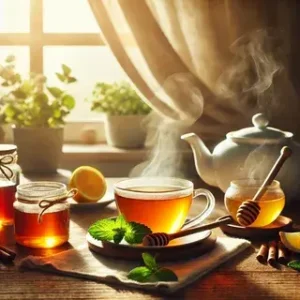I’ll never forget the first time I tried taro bubble tea. It was a sweltering summer day in Taipei, and I stumbled into a cramped tea shop to escape the heat. The menu was overwhelming—pages of flavors like matcha, mango, and brown sugar—but the vibrant lavender drink in the customer’s hand caught my eye. “What is that?” I asked. Ten minutes later, I was hooked: creamy, subtly sweet, with chewy tapioca pearls that made every sip an adventure.
To put it simply, taro bubble tea is more than a trend; it’s a cultural phenomenon. From 1980s Taiwan to its Instagram-motivated glory today, it is a combination of tradition, visual appeal, and flavors in one cup. But what makes it so interesting? And can you ever make it at home without ending up with a lumpy-purple disaster?
I’ll explain the ins and outs of taro bubble tea, provide detailed recipes, disclose the mistakes that damaged my initial batches, and walk you through my five-year journey from inquisitive drinker to bubble tea connoisseur in this guide. Let’s get started!
Section 1: What Is Taro Bubble Tea? Breaking Down the Basics
Taro bubble tea (or “taro boba”) is a creamy, mildly sweet drink made from taro root, milk, tea, and tapioca pearls. Its signature purple hue and nutty vanilla flavor have made it a staple in bubble tea shops worldwide.
Key Components:
- Taro Root: Southeast Asian taro root is a starchy tuber with purple flesh. When cooked, it tastes like a hybrid of vanilla and sweet potato.
- Tapioca Pearls: Made from cassava starch, tapioca pearls are chewy, marble-sized balls. The term “bubble” tea comes from the fact that they sink to the bottom.
- Milk or Creamer: Taro’s earthiness is counterbalanced by milk or creamer. If you don’t have dairy, oat or coconut milk also works.
- Tea Base: Some recipes omit the tea base, which is often black or green tea, for a smoother flavor.
A Brief History
Bubble tea originated in Taiwan in the 1980s, when a teahouse owner added tapioca pearls to her iced tea. Taro emerged as a popular flavor due to its natural sweetness and eye-catching color. By the 2000s, it had spread globally, thanks to social media’s love for photogenic foods.
Why It Matters Today: With origins in traditional Asian cooking, taro bubble tea is a contemporary pleasure that transcends generations. It’s also incredibly customizable and vegan-friendly (when made using plant-based milk).
Section 2: How to Make Taro Bubble Tea at Home: A Step-by-Step Guide
Confession: My first homemade attempt looked like murky dishwater. But after trial and error, here’s the foolproof method.
Tools You’ll Need
- Blender
- tiny pot (used to boil pearls)
- A strainer
- (For the pearls!) Big straw!
Ingredients
- 1 cup cooked taro root (fresh or frozen)
- 1/2 cup tapioca pearls
- 1 cup brewed jasmine tea (chilled)
- 1/2 cup milk (or coconut milk for richness)
- 1–2 tbsp honey or simple syrup
- Ice
Steps
- Cook the Tapioca Pearls:
Cook the tapioca pearls by boiling them for 15 to 20 minutes until they are chewy, and then washing them with cold water. To keep it from sticking, toss with honey. - Blend the Taro Base:
In a blender, mix together cooked taro, milk, tea, and sugar. Blend until smooth. - Assemble:
Fill a glass with pearls, then add the taro mixture, cover with ice, and stir.
Homemade vs. Store-Bought Taro Powder: Which Wins?
| Feature | Homemade Taro Paste | Store-Bought Powder |
|---|---|---|
| Flavor | Earthy, nuanced | Sweeter, artificial |
| Prep Time | 30+ minutes | 5 minutes |
| Customization | Full control | Limited |
| Cost | $$ (fresh taro) | $ (per serving) |
Verdict: Homemade tastes fresher, but powder is convenient. For beginners, try powder first (I use WuFuYuan Taro Mix).
Section 3: 7 Common Taro Bubble Tea Mistakes to Avoid
- Overcooking Tapioca Pearls
The texture is ruined by mushy pearls. When my “boba” transformed into tasteless jelly blobs, I had to learn this the hard way. Observe the package’s time! - Using Raw Taro
Raw taro is toxic when ingested. Always cook it thoroughly—steam or boil until fork-tender. - Skipping the Tea Base
Without tea, the drink becomes overly heavy. Even a subtle jasmine or oolong layer adds balance. - Ignoring Sweetness Levels
Taro is naturally mild. Taste as you go; my first batch was cloying because I added 5 tablespoons of sugar. - Artificial Food Coloring
Some shops use neon purple dye instead of real taro. Opt for brands with natural ingredients.
Section 4: My Taro Bubble Tea Journey: From Clumpy Disaster to Boba Master
Phase 1: The Infatuation
After my Taipei trip, I hunted taro boba everywhere. Los Angeles, New York, and even a gas station in Nebraska (spoiler: it was terrible).
Phase 2: The DIY Disaster
My initial homemade try used undercooked taro and instant coffee instead of tea. It was grainy, and bitter, and earned a “0/10” review from my roommate.
Phase 3: Small Wins
I invested in a good blender and real tapioca pearls. Success came when I nailed the tea-to-milk ratio (2:1) and learned to simmer taro for 25 minutes.
Phase 4: Sharing the Love
Now, I host boba nights for friends. The crowning moment was when a Taiwanese friend said, “This tastes like home.”
FAQs: Your Taro Bubble Tea Questions, Answered
Q: Is taro bubble tea healthy?
A: In moderation! Taro is rich in fiber and vitamins, but sugary syrups add calories. Use honey or stevia for a lighter version.
Q: Can I make it without tapioca pearls?
A: Absolutely. Try chia seeds or lychee jelly for texture.
Q: Does it contain caffeine?
A: Only if you add tea. Skip it for a caffeine-free treat.
Q: Why is my taro drink gray instead of purple?
A: You might’ve used white-fleshed taro. Add a splash of beet juice for color—no one will know!
Q: What’s the biggest myth about taro bubble tea?
A: That it’s “just a kids’ drink.” High-quality taro has a sophisticated, earthy flavor adults love.
Conclusion: Ready to Brew Your Own Boba Masterpiece?
Taro bubble tea is more than a drink—it’s a craft. You’ll mess up (I certainly did), but the journey is half the fun. Start small: buy reliable taro powder, master the pearls, then experiment with fresh ingredients.
It is helpful and engaging. Remember, the joy of food is in the discovery and sharing of flavors. Happy sipping, and may your journey with taro bubble tea be as colorful and delightful as the drink itself




